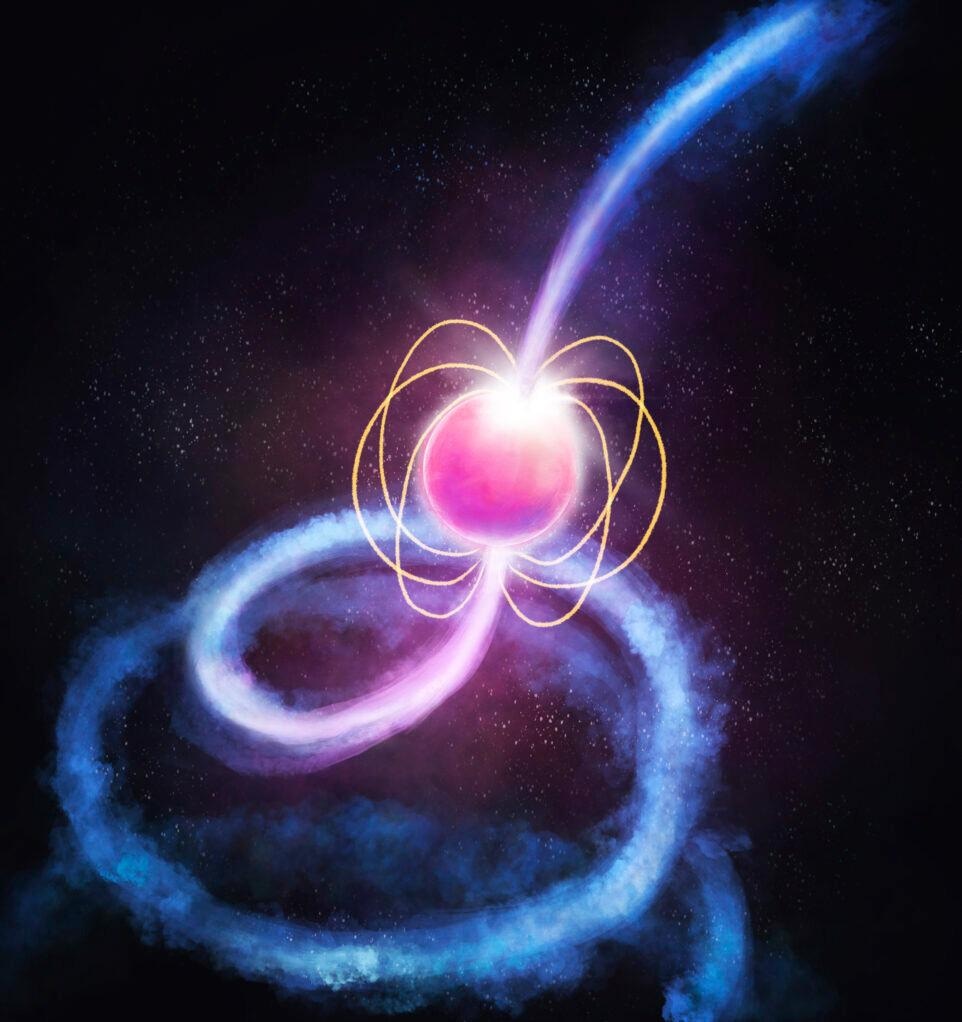Apr 21 2021
A pulsar, a dense and quickly spinning neutron star that emits radio waves into the cosmos, has been found by astronomers with the help of a low-frequency radio telescope in outback Australia.
 An artist’s impression of Pulsar—a dense and rapidly spinning neutron star sending radio waves into the cosmos. Image Credit: International Centre for Radio Astronomy Research / Curtin University.
An artist’s impression of Pulsar—a dense and rapidly spinning neutron star sending radio waves into the cosmos. Image Credit: International Centre for Radio Astronomy Research / Curtin University.
The detection of the pulsar was achieved using the Murchison Widefield Array (MWA) telescope, located in the remote Mid-West region of Western Australia. Although this is the very first time researchers have found a pulsar with the MWA, they believe it will be the first one of many.
The study results are an indication of things to originate from the multi-billion-dollar Square Kilometre Array (SKA) telescope. The MWA is considered a precursor telescope for the SKA.
Nick Swainston, a PhD student at the Curtin University node of the International Centre for Radio Astronomy Research (ICRAR), achieved the breakthrough while processing data that was gathered as part of a current pulsar survey.
Pulsars are born as a result of supernovae—when a massive star explodes and dies, it can leave behind a collapsed core known as a neutron star. They’re about one and a half times the mass of the Sun, but all squeezed within only 20 kilometres, and they have ultra-strong magnetic fields.
Nick Swainston, PhD Student, Curtin University Node, International Centre for Radio Astronomy Research
Mr Swainston added that these pulsars spin quickly and discharge electromagnetic radiation from their magnetic poles.
“Every time that emission sweeps across our line of sight, we see a pulse—that’s why we call them pulsars. You can imagine it like a giant cosmic lighthouse,” explained Mr Swainston.
According to Dr Ramesh Bhat, an astronomer from ICRAR-Curtin, the newly found pulsar is situated over 3000 light-years from Earth and spins about once each second.
“That’s incredibly fast compared to regular stars and planets. But in the world of pulsars, it’s pretty normal,” added Dr Bhat, who noted that the discovery was achieved using around 1% of the huge volume of data gathered for the pulsar survey.
“We’ve only scratched the surface. When we do this project at full-scale, we should find hundreds of pulsars in the coming years,” he explained
Astronomers use pulsars for various applications, such as testing the laws of physics under severe conditions.
A spoonful of material from a neutron star would weigh millions of tones. Their magnetic fields are some of the strongest in the Universe—about 1000 billion times stronger than that we have on Earth. So we can use them to do physics that we can’t do in any of the Earth-based laboratories.
Dr Ramesh Bhat, Astronomer, Curtin University Node, International Centre for Radio Astronomy Research
Moreover, identifying pulsars and making use of them for extreme physics is considered a crucial science driver for the SKA telescope.
According to Steven Tingay, Professor and MWA Director, the breakthrough points toward a huge population of pulsars pending discovery in the Southern Hemisphere.
This finding is really exciting because the data processing is incredibly challenging, and the results show the potential for us to discover many more pulsars with the MWA and the low-frequency part of the SKA. The study of pulsars is one of the headline areas of science for the multi-billion-dollar SKA, so it is great that our team is at the forefront of this work.
Steven Tingay, Professor and Director, Murchison Widefield Array
Radio wave emission from a pulsar
Video Credit: International Centre for Radio Astronomy Research.
Journal Reference:
Swainston, N. A., et al. (2021) Discovery of a steep-spectrum low-luminosity pulsar with the Murchison Widefield Array. The Astrophysical Journal Letters. doi.org/10.3847/2041-8213/abec7b.